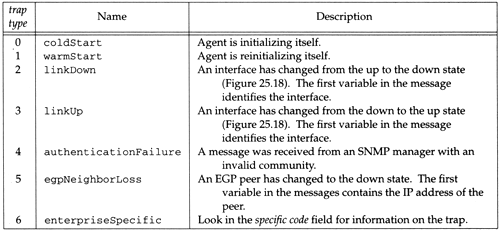25.10 Traps
25.10 Traps
All the examples we've looked at so far in this chapter have been from the manager to the agent. As shown in Figure 25.1, it's also possible for the agent to send a trap to the manager, to indicate that something has happened on the agent that the manager might want to know about. Traps are sent to UDP port 162 on the manager.
In Figure 25.2 we showed the format of the trap PDU. We'll go through all the fields in this message when we look at some tcpdump output below.
Six specific traps are defined, with a seventh one allowing a vendor to implement an enterprise-specific trap. Figure 25.30 describes the values for the trap type in the trap message (Figure 25.2).
Figure 25.30. Trap types.

We can see some traps using tcpdump. We'll start the SNMP agent on the system sun and see it generate a coldStart trap. (We tell the agent to send traps to the host bsdi. Although we're not running a manager on bsdi to handle the traps, we can run tcpdump and see what packets get generated. Recall from Figure 25.1 that a trap is sent from the agent to the manager, but there is no acknowledgment sent by the manager, so we don't need a manager to handle the traps.) We then send a request using the snmpi program, but with an invalid community name . This should generate an authenticationFailure trap. Figure 25.31 shows the output.
Figure 25.31. tcpdump output of traps generated by SNMP agent.

First we notice that both UDP datagrams are from the SNMP agent (port 161, printed as the name snmp ) with a destination port of 162 (printed as the name snmp-trap ).
The notation C=traps is the community name of the trap message. This is a configuration option with the ISODE SNMP agent being used.
The next notation, Trap (28) in line 1 and Trap (29) in line 2 is the PDU type and length.
The next field of output for both lines is E:unix.1.2.5. This is the enterprise: the agent's sysObjectID. It falls under the 1.3.6.1.4.1 node of the tree in Figure 25.6 (iso.org.dod.internet.private. enterprises ), so this agent's object identifier is 1.3.6.1.4.1.4.1.2.5. Its abbreviated name is unix. agents .fourBSD-isode.5. The final number (5) is the version number of this release of the ISODE agent. This enterprise value identifies the agent software generating the trap.
The next field output by tcpdump is the IP address of the agent (140.252.13.33).
The trap type is printed as coldStart on line 1, and authenticationFailure on line 2. These correspond to trap type values of 0 and 4, respectively (Figure 25.30). Since these are not enterprise-specific traps, the specific code must be 0, and is not printed.
Next comes the timestamp field, printed as 20 and 1907. This is a TimeTicks value, representing the number of hundredths of a second since the agent initialized. In the case of the cold start trap, the trap was generated 200 ms after the agent was initialized . The tcpdump output indicates that the second trap occurred 18.86 seconds after the first one, which corresponds to the printed value of 1907 hundredths of a second, minus 200 ms.
Figure 25.2 indicates that a trap message can contain interesting variables that the agents wants to send to the manager, but there aren't any in our examples.
EAN: 2147483647
Pages: 378